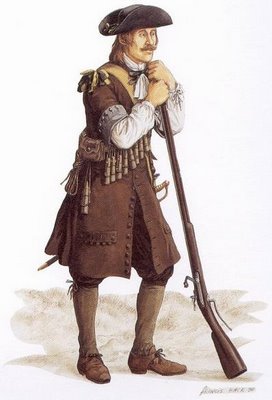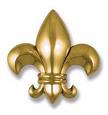 The depiction of a soldier from the Carignan-Salières Regiment
The depiction of a soldier from the Carignan-Salières Regiment
In 1662 when Pierre Boucher returned to France to solicit the support of Louis XIV and Colbert to save the threatened colony from the Iroquois, the raids and massacres and sheer terrorism was about to end the notion of colonization in the new world for the French. Farming had become almost impossible in the settlements of Montréal and Trois-Rivières. People going in the fields to work had to have armed guards with them, militia or fellow citizens. It seemed every tree had a warrior lurking behind it. The raids were fast and furious, always leaving blood and fire in their wake.
Pierre Boucher describes the situation: "They can set up an ambush anywhere; a small bush can conceal six or seven of these barbarians...We are always in fear that some unfortunate man not be able to work in safety if he wanders off the least distance. A woman lives with the constant fear that her husband, who has left that morning to work, will be killed or captured and that she will never see him again."
From the Jesuit Relations: "They come like foxes through the woods, they attack like lions, they take flight like birds. They would pass before Quebec in broad noonday and no one could pursue them or recover the prisoners."
In 1640, the Iroquois had destroyed the Huron nation in a war.
As a result of Boucher's meeting with King Louis XIV, he was promised help. In 1662, two ships arrived in Canada with 100 soldiers. A start. The power of the Company of 100 Associates was withdrawn. Another step forward. However, it was only in 1663, when King Louis XIV took charge, did the colony prosper. Even though, the long sought-after help in protecting the colony did not materialize until 1665, the arrival of the Carignan Regiment, twelve hundred strong of well trained soldiers that summer changed the situation dramatically. With the help of the local militia, they, within a year, put an end to the Indian War. Although there was the occasional renegade and marauder still plying the woods, the Colony was now at peace, and had a population of approximately four thousand souls.

Better than 400 soldiers and officers decided to become settlers in Canada after the Carignan Regiment was recalled to France in 1667. This was encouraged and they were given bonuses, and sometimes a promise of land if they chose to remain.
In my family tree, there are 22 soldiers, 1 lieutenant and 1 ensign among the group. Of the soldiers and officers, 17 of them are in the Cameron family, and 7 are part of the Lizottes. They are all listed below, showing the settler's name, his dit name and the Company he served with.
Jean BESSET dit Brisetout (LaTour)
Jacques BIDET dit de Russel or des Roussels (Maximy)
Nicolas Vincent BOISSONNEAU dit Xaintonge (Maximy)
Pierre BOULANGER dit le Boulanger (Loubias), a corporal
Jean CHASTENAY dit la Guigne (St. Ours)
Pierre COQUIN dit la Tonell or la Tournelle (Grandfontaine)
Jean Jacques GERLAISE dit St. Amand (La Fouille) ... (surname can be DeGerlais)
Pierre HUDON dit Beaulieu (Grandfontaine)
André JARRET dit Beauregard... a lieutenant (Contrecoeur)
André MIGNIER dit Lagassé or Lagacé (Berthier)
Michel ROGNON dit La Roche (Monteil)
Jean LAUZÉ dit Matta or Matha (Maximy)
Pierre LOZOULT dit LaTour (Loubias) ... (surname can be spelled Loiseau, Lozault, Lozeau or Lozeaux)
Pierre MEUNIER dit LaPierre (St. Ours)
Jean MOREAU dit Jolicoeur (LaVarenne)
Pierre MOUËT de Moras... an Ensign (Loubias)
Claude PASTOUREL dit LaFranchise (Saurel)
Mathurin RENAUD dit Boisjoli (Maximy)
Guillaume RENAULT (Colonelle)
Pierre RICHER dit LaFlèche (Grandfontaine
Louis ROBERT dit LaFontaine or LaPommeraye (Loubias)
Jean ROBIN dit LaPointe (Saurel)
Antoine ROY dit Desjardins (Froment)
Mathurin VILLENEUVE (Monteil)